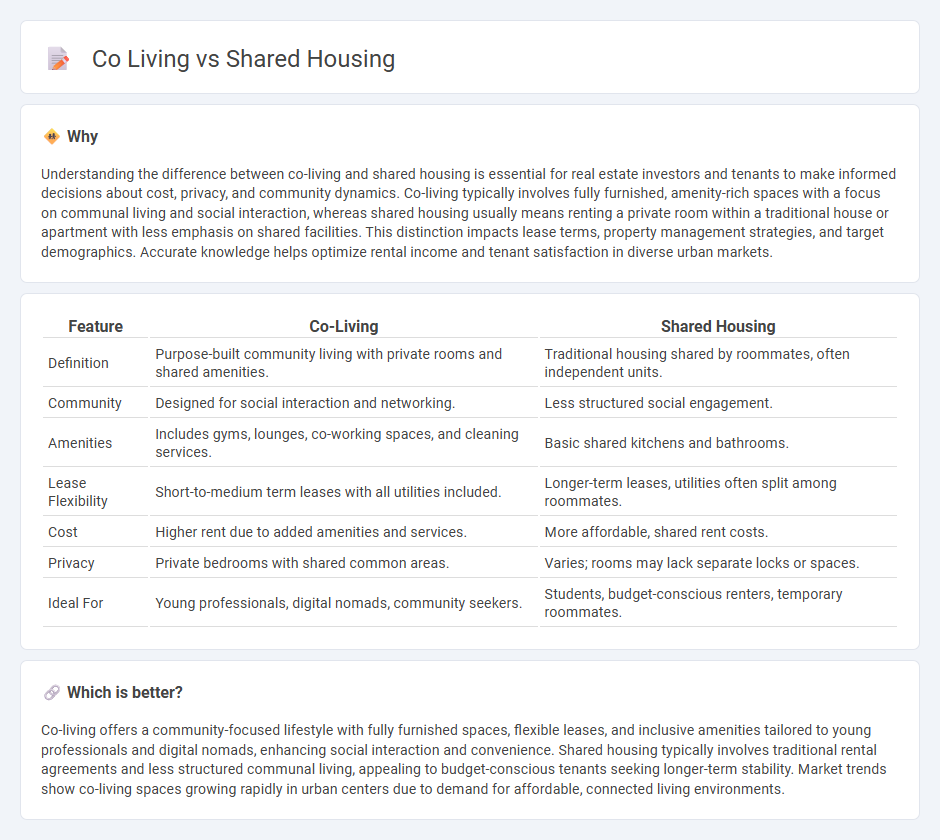
Co-living offers fully furnished, community-focused spaces with flexible lease terms designed for urban professionals seeking convenience and social engagement. Shared housing typically involves renting private rooms in a larger home, often with less emphasis on communal amenities and more on cost-saving. Explore the key differences to determine which living arrangement suits your lifestyle and budget best.
Why it is important
Understanding the difference between co-living and shared housing is essential for real estate investors and tenants to make informed decisions about cost, privacy, and community dynamics. Co-living typically involves fully furnished, amenity-rich spaces with a focus on communal living and social interaction, whereas shared housing usually means renting a private room within a traditional house or apartment with less emphasis on shared facilities. This distinction impacts lease terms, property management strategies, and target demographics. Accurate knowledge helps optimize rental income and tenant satisfaction in diverse urban markets.
Comparison Table
| Feature | Co-Living | Shared Housing |
|---|---|---|
| Definition | Purpose-built community living with private rooms and shared amenities. | Traditional housing shared by roommates, often independent units. |
| Community | Designed for social interaction and networking. | Less structured social engagement. |
| Amenities | Includes gyms, lounges, co-working spaces, and cleaning services. | Basic shared kitchens and bathrooms. |
| Lease Flexibility | Short-to-medium term leases with all utilities included. | Longer-term leases, utilities often split among roommates. |
| Cost | Higher rent due to added amenities and services. | More affordable, shared rent costs. |
| Privacy | Private bedrooms with shared common areas. | Varies; rooms may lack separate locks or spaces. |
| Ideal For | Young professionals, digital nomads, community seekers. | Students, budget-conscious renters, temporary roommates. |
Which is better?
Co-living offers a community-focused lifestyle with fully furnished spaces, flexible leases, and inclusive amenities tailored to young professionals and digital nomads, enhancing social interaction and convenience. Shared housing typically involves traditional rental agreements and less structured communal living, appealing to budget-conscious tenants seeking longer-term stability. Market trends show co-living spaces growing rapidly in urban centers due to demand for affordable, connected living environments.
Connection
Co-living and shared housing both emphasize community-oriented living spaces where residents share amenities to reduce costs and promote social interaction. These housing models optimize urban real estate by maximizing occupancy and providing affordable options in high-demand areas. Technology-driven management platforms often facilitate coordination and maintenance, enhancing the appeal of shared living arrangements.
Key Terms
Lease Agreement
Shared housing lease agreements typically involve individual leases for each tenant or a single lease with joint and several liability, ensuring clear responsibilities for rent and utilities. Co-living agreements often feature flexible, short-term leases with inclusive amenities and community rules designed to foster social interaction and shared living experiences. Explore more to understand the legal nuances and benefits of each housing option's lease structure.
Communal Spaces
Communal spaces in shared housing often consist of basic common areas such as living rooms and kitchens, designed for casual interactions among residents. Co-living spaces prioritize well-designed, multifunctional communal areas that foster community engagement and facilitate social activities, often including co-working zones, lounges, and event rooms. Explore more about how communal space design influences lifestyle and social connections in shared housing versus co-living arrangements.
Private Rooms
Private rooms in shared housing often provide greater privacy but may lack community-focused amenities commonly found in co-living spaces, which emphasize shared experiences and social interaction. Co-living arrangements typically include furnished private rooms with access to communal areas, utilities, and organized events to foster connections among residents. Explore the distinctions in private room offerings and communal benefits to determine the best fit for your lifestyle.
Source and External Links
Shared Housing Fact Sheet - This document outlines shared housing as a model where two or more people live in a rental unit, sharing costs such as rent and utilities.
Living with Other People - This article discusses the concept of shared living, where individuals can reside together in various settings, benefiting from cost savings and mutual support.
National Shared Housing Resource Center - This organization connects non-profit homesharing programs across the U.S., facilitating shared housing opportunities for those in need.
 dowidth.com
dowidth.com